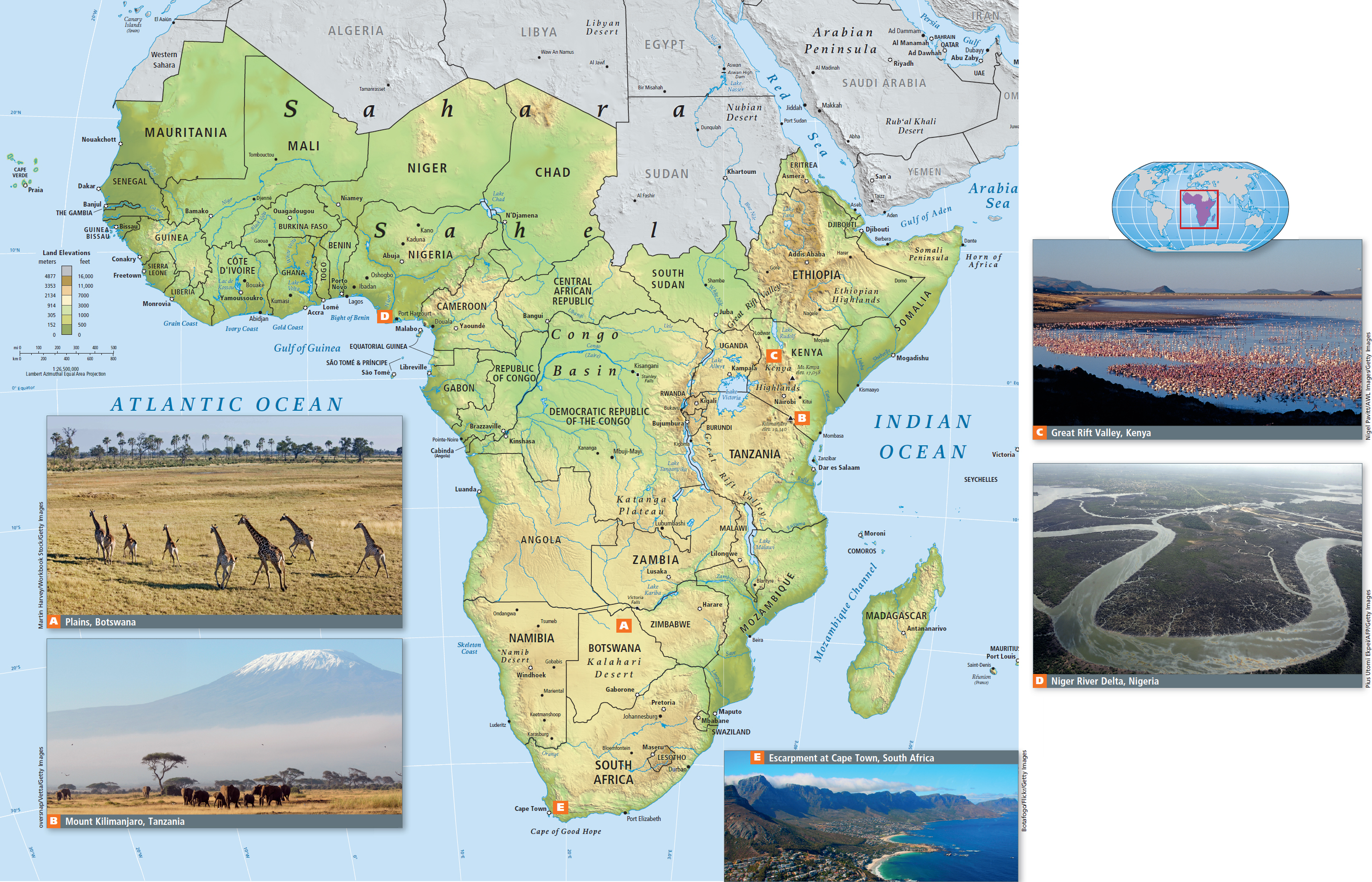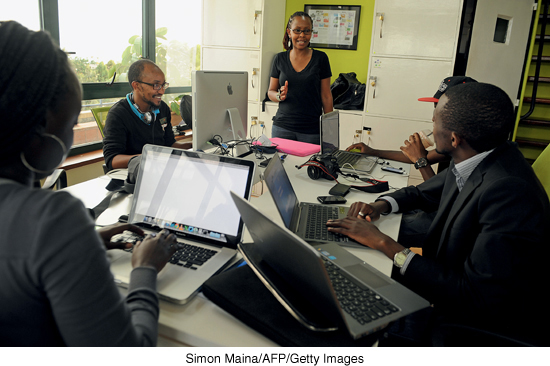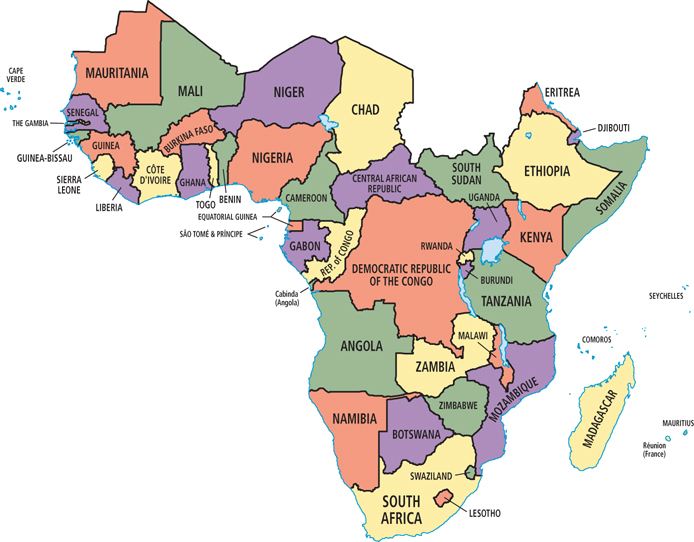The Sub-Saharan Region
Sub-Saharan Africa (Figure 7.1) contains 48 countries and occupies a space bigger than North America and Europe combined. However, it is not particularly densely populated. This region is the ancient home of modern humans; it has megafauna that most of us will see only in zoos and has a broad variety of landscapes. But it is not a region that is well known to most and is often erroneously thought of as desperately poverty-stricken and barely capable of helping itself.

Figure 7.1: Regional map of sub-Saharan Africa.
The five thematic concepts in this book are explored as they arise in the discussion of regional issues; the interactions between two or more themes are often featured. Vignettes, like the one that follows about Juliana Rotich, illustrate one or more of the themes as they are experienced in individual lives.
Although sub-Saharan Africa (see Figure 7.1) is often portrayed as a place mired in seemingly unsolvable problems related to poverty, disease, corruption, and conflict, it actually has many success stories. Highly competent women and men, such as Juliana Rotich, use a powerful language of opportunity, optimism, and innovation to characterize the Africa they know today. In 2012, six of the ten fastest-growing economies in the world were in sub-Saharan Africa. World Bank studies (2010) indicate that a number of countries, such as Congo (Brazzaville), with some of the world’s richest deposits of oil, gold, platinum, copper, and other strategic minerals, are taking control of mineral resources and using the profits to reduce poverty.
During the era of European colonialism (the 1850s to the 1950s), this region’s massive wealth of human talent and natural resources flowed out of Africa to Europe and the Americas. Even after African countries became politically independent in the 1950s, 1960s, and 1970s, wealth continued to flow out of Africa. Now, wealth is being increasingly created in Africa for Africans. While much of region is impoverished and parts are in armed conflict, there are many hopeful signs that discord is diminishing and well-being increasing.
GLOBAL PATTERNS, LOCAL LIVES
Few people in the East African country of Kenya have computers, but nine of ten Kenyans have mobile phones. They use these simple and inexpensive devices (not smart phones) with texting (SMS) capabilities and perhaps a camera for a multitude of tasks that are done on computers in Europe or North America. One of the most consequential tasks is mobile banking—sending and receiving money via mobile phone. More than 20 percent of the Kenyan gross domestic product (GDP) flows through the mobile banking system. This means that owners of even the smallest businesses can order materials and pay bills and employees without having to pay for expensive equipment and accounting systems or making an expensive time-consuming trip to a bank in a distant city. Small-scale farmers with crops to sell can use SMS to find out where the best market is at the moment and can maximize their profits by bypassing middlemen who charge high fees.
Juliana Rotich (Figure 7.2) grew up in a small town in Kenya, just as Africa was first experiencing the mobile phone and Internet revolutions in communication. She was admitted to a U.S. university, where she became an IT major. She then collaborated with friends in the online community to found and run Ushahidi, a web-based, open source reporting system with interactive mapping capabilities that is now widely used throughout the world. Ushahidi, which means “testimony” in Swahili, was originally designed for quickly sharing information about the violence that broke out in Kenya during the 2008 elections. A user can connect to Ushahidi through a phone or a Web site to instantly learn specific details about a situation. Information gathered from hundreds or even thousands of users (in a process called crowdsourcing) can be verified, mapped, and disseminated in real time.

Figure 7.2: Juliana Rotich. Juliana Rotich (standing) is a young Kenyan telecommunications specialist with a computer science degree from the University of Missouri. She founded and directs the company that created Ushahidi, a crowd sourcing platform that enables mobile phone users to map crisis information in order to be able to quickly respond to the crises. Ushahidi is now used around the world. Rotich, who also writes a respected blog, Afromusing, is part of a growing number of educated Africans who focus on applying technology to African development needs.
Many people benefit when the barriers to the use of technology are lowered and suddenly virtually everyone has new and useful tools—in this case, a particular software tool and mobile phones—in their hands. The businesspeople and farmers of Kenya have clearly been beneficiaries; but rescuers have also been able to use the Ushahidi software—with its mapping capabilities—to locate people buried by earthquakes in Haiti, Chile, and Japan. Ushahidi enabled crucial communication between dissidents during and after the Arab Spring revolutions in Libya and Egypt and during the Syrian civil war (Figure 7.3). Within sub-Saharan Africa, Ushahidi is now being used to aid in disease control, health care, political reform, wildlife inventorying, and the control of corruption. [Source: “99 Faces.” For detailed source information, see Text Sources and Credits.]

Figure 7.3: Ushahidi platform users worldwide. The map shows a selection of the 132 countries in which Ushahidi has been deployed.
What Makes Sub-Saharan Africa a Region?
Sub-Saharan Africa is a region distinct from North Africa for physical, cultural, and historical reasons. The Sahara Desert and the Sahel—that grassy transition zone between the desert and wetter climes to the south—present major physical obstacles to human habitation (though trading caravans have traversed the Sahara and Sahel for thousands of years). Because of this, sub-Saharan Africa developed largely separate from North Africa. For millennia, sub-Saharan Africa was known to the outside world only by the accounts of a few travelers, such as those of the Arab explorer Ibn Battuta, who traveled widely throughout the region in the 1300s. In the mid-1400s, however, the Portuguese sent their exploratory fleets down the west coast of Africa, beginning a 600-year-long period of European colonialism that transformed sub-Saharan Africa.
Sahel a band of arid grassland, where steppe and savanna grasses grow, that runs east-west along the southern edge of the Sahara
Page 277
Page 278
The Europeans noted what for them were exotic qualities: dark-skinned people with unique and varied ways of life and cultures, who possessed valuable trade items, such as precious minerals, exotic plants and animals, and fine textiles. For centuries, however, Europeans discounted the sophistication and complexity of sub-Saharan Africa’s cultural and historical heritage of horticulture, weaving, mining, and metalwork. Everything south of the Sahara was lumped into “Black Africa,” and for some this term is still used to distinguish the region from Africa as a whole.
In this chapter, we refer only occasionally to the whole continent, and then we refer to it simply as Africa. Sub-Saharan Africa is defined by the countries shown in Figure 7.4. For cultural and historical reasons, the new country of South Sudan is included in this region. For similar reasons, the country of Sudan is not included because its location on the Nile River and the strong Arab influence in the capital of Khartoum have brought Sudan into closer association with North Africa and Southwest Asia. Sudan is instead discussed in Chapter 6.

Figure 7.4: Political map of sub-Saharan Africa.
The names of African countries can often be confusing. For example, there are two neighboring countries called Congo—the Democratic Republic of the Congo and the Republic of Congo. Because these designations are both lengthy and easily confused, we abbreviate them in this text. The Democratic Republic of the Congo (formerly Zaire) carries the name of its capital in parentheses: Congo (Kinshasa). The Republic of Congo is called Congo (Brazzaville). Check the regional map in Figure 7.1 to see the locations of these countries and capitals.
THINGS TO REMEMBER
The many stereotypes of sub-Saharan Africa—that it is a region of conflict, disease, corruption, and poverty—are being countered by young, educated Africans who are constructing new public agencies and private businesses, often grounded in modern technology, in their home countries.
Some sub-Saharan countries now have economies that are among the fastest-growing in the world.




